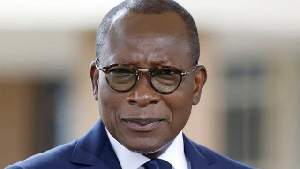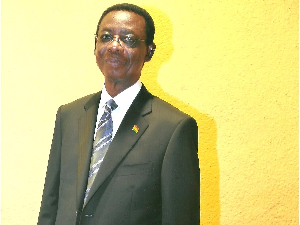*“Developing countries in Africa have been more concerned with bridging the
gaps of inequality with the developed countries, whiles the developed
countries have been more concerned with increasing the gaps of inequality
with the developing countries.”*
Development is a term which came into vogue after World War II when
development economists attempted to design appropriate development models
for developing countries to catch up with the developed world. The word
development is however very difficult to define. Over the years, there has
been long debate over the exact definition of the concept development.
Different scholars have viewed development from different perspectives.
Some of these perspectives have been examined below with analysis based
Michael P. Todaro and Stephen C. Smith book on Economic Development, ninth
edition.
According to the Traditional Economic Perspectives, in strictly economic
terms development has traditionally meant the capacity of a national
economy, where initial economic condition has been more or less static for
a long time, to generate and sustain an annual increase in its Gross
National Income (GNI). A common alternative economic index of development
has been the use of rates of growth of income per capita. Development
strategies have therefore usually focused on rapid industrialization, often
at the expense of agriculture.
Dudley Seers used poverty, unemployment and inequality as indicators for
measuring development instead of economic indicators. Dudley Seers posed
the basic question about the meaning of development succinctly when he
asserted, “the questions to ask about a country’s development are
therefore: What has been happening to poverty? What has been happening to
unemployment? What has been happening to inequality? If all three of these
have declined from high levels, then beyond doubt this has been the period
of development for the country. If one or two of these problems have been
growing worse especially if all three have, it would be strange to call the
result ‘development’ even if per capita income doubled”(Seers, 1969:3 cited
in Conyers and Hills, 1984: 29-30). Development must therefore be conceived
of as a multidimensional process involving major changes in social
structures, popular attitudes and national institution as well as the
acceleration of economic growth, the reduction of inequality and
eradication of poverty.
Amertya Sen’s “Capabilities” Approach, Sen argues that the “capability to
function” is what really matters as a poor or nonpoor person. As Sen put it
“Economic growth cannot be sensibly treated as an end in itself.
Development has to be more concerned with enhancing the lives we lead and
the freedom we enjoy. Functioning that is what a person does (can do) with
the commodities of a given characteristics that they come to possess or
control. The concept of functioning reflects the various things a person
may value doing or being. Sen define capabilities, as “the freedom that a
person has in terms of the choice of functioning, given his personal
features and his command over commodities”.
UNDP’s Multidimensional Measurement, since 1990 the UNDP has primarily
focused on human development in its Human Development Index (HDI) as
measured by three major indicators. These are Health, Education and Income.
In Micheal P. Tadoro and Stephen C. Smith book, Economic Development, they
highlighted three core values of development which serve as conceptual
ground and indicators for comprehending the concept of development. Firstly
Sustenance: the ability to meet basic needs. All people have certain basic
needs without which life would be impossible. Secondly Self Esteem: To be a
person. A sense of worth and self respect, of not being used as a tool by
the others for their own needs due to the significance attached to material
values in developed nations, worthiness and esteem are nowadays
increasingly conferred only on countries that possess economic wealth and
technological power. Thirdly, freedom from servitude: To be able to choose.
Freedom here is to be understood in the sense of emancipation from
alienating material conditions of life and from servitude to nature,
ignorance, other people, misery, institutions and dogmatic beliefs,
especially that poverty is predestination. The three objectives of
development therefore are, To increase the availability and widen the
distribution of basic life-sustaining goods such as food, shelter, health
and protection, To raise levels of living, including, in addition to higher
incomes, the provision of more jobs, better education and greater attention
to culture and human values which will help generate greater individual and
national self-esteem and To expand the range of economic and social choices
available to individuals and nations by freeing them from servitude and
dependence.
The final perspectives worthy of mentioning is the Post-Modernism Idea of
Development, they argue that the concept of development is not practical
and just a body of ideas and theories used by the Western world to dominant
the third world countries. They entreat Third World countries to craft
their own conceptual understanding of development that best address their
needs.
Africa In Perspective
For the purpose of digesting the issue of developing countries in Africa
having been more concerned with bridging the gaps of inequality with the
developed countries with the developed countries, while the developed
countries have been more concerned with increasing the gaps of inequality
with the developing countries, I have decided to craft my understanding for
development which is development been a multidimensional process which
involve using the means of development (i.e. Natural resources,
Institutions and Human actors) to address the goals of development (i.e.
either to reduce or to create socio-economic and political inequality of
well-being within or across societies) in addition to the cultural and
political requirement for effecting rapid structural and institutional
transformations of entire societies in a manner that will most efficiently
bring the fruits of economic progress to the broadest segments of their
populations.
According to the Collins COBUILD Advanced Learner’s ENGLISH DICTIONARY,
Inequality is the difference in social status, wealth, or opportunity
between people or groups. Situating the meaning of inequality into the
context of the issue under discussion, inequality can be explain as the
difference in social, economic, political advancement and infrastructure
coupled with institutional progress among countries.
Developing countries are deemed to have low level of per capita income, low
industrialization, low literacy rate, poor living standard and weak
institutions coupled with inadequate technological infrastructure.
Developing countries have been bedeviled with Weak institutions, Dependence
on and vulnerability to foreign exploitation, High illiteracy rate, High
levels of unemployment, Prevalence of endemic diseases, Limited
technological capacity, High infant mortality rate, Malnutrition, Poor
sanitation, Unequal distribution of income etc.
Examination of the characteristics of developing countries will better
explain the reason why developing countries in Africa have been more
concern with the bridging the gaps of inequality with the developed
countries. A point worth noting is that the developed countries have
already passed through this stage and characteristics that the developing
countries are currently in. In examining the characteristics of developing
countries, reference is made to Michael P. Todaro and Stephen C. Smith book
on Economic Development, chapter two.
The first point worth mentioning is low levels of living, characterized by
low incomes, inequality, poor health and inadequate education. In
developing countries, the levels of living tend to be very low for the vast
majority of people. These low levels of living are manifested
quantitatively and qualitatively in the form of low life and work
expectancies, high infant mortality rate and in many cases a general sense
of malaise and hopelessness.
Secondly, dependence and vulnerability in international relations, for many
developing countries a significant factor contributing to the persistence
of low levels of living, rising unemployment, and growing income inequality
is the highly unequal distribution of economic and political power between
rich and poor nations. These unequal strength are manifested not only in
the dominant power of rich nation to control the pattern of international
trade and agreements regulating it but also in their ability often to
dictate the terms whereby technology, foreign aid, and private capital are
transferred to developing countries.
Furthermore, substantial dependence on agricultural production and
primary-product exports, the vast majority of people in developing nations
live and work in the rural areas. The basic reason for the concentration of
people and production in agricultural and other primary production
activities in developing countries is the simple fact that at low income
levels, the first priorities of any person are food, clothing and shelter.
Agricultural productivity is low not only because of the large numbers of
people in relation to available land but also because developing countries
agriculture is often characterized by primitive technologies, poor
organization and limited physical and human inputs. Technological
backwardness persists because developing country agriculture is
predominantly noncommercial peasant farming.
The final characteristic of developing countries to be digested is the
prevalence of imperfect market and limited information. It is worth noting
that the presumed benefits of market economics and market- friendly
policies depend heavily on the existence of institutional, cultural and
legal prerequisites that most of us in industrial societies take for
granted. In many developing countries, these legal and institutional
frameworks are either absent or extremely weak. These situations do not
allow for the enforcement of contracts and validation of property rights, a
stable and trustworthy currency, an infrastructure of roads and utilities
that result in low cost of transport and communication. Moreover,
information is limited and costly to obtain, thereby often causing goods,
finances, and resources to be misallocated.
Examining the characteristics of the developing countries is clearly
obvious that developing nations needed to bridge this vast gap of
inequality comparing with the developed countries. Any development policies
must be geared towards mitigating this extreme level socio-economic and
political couple with institutional inequalities. Educational
infrastructures, economical stability, political independence and strong
institutional framework are the key areas that the developing countries
must endeavor to bridge the gap that have been created internally by poor
institutional framework and externally by the developed countries. Since
developing countries are in a gradual process of developing, these
inequalities must necessarily be bridge for them to achieve their
development targets of economic stability, technological infrastructure,
political independent and strong institutional framework.
Now a cursory look at the developed countries and how they are more
concerned with creating inequalities with the developing countries,
according to Kofi Annan, former Secretary General of the United Nations, “A
developed country is one that allows its citizens to enjoy a free and
healthy life in a safe environment.” Developed countries are mostly
characterized by high level of industrialization, high literacy rate, and
lower level of unemployment, better sanitation, accessible medical
services, democratic government, a stable currency and well functioning
institutions.
In my candid opinion, the developed nations have over the decades thrown
out policies and program that have created inequalities with developing
countries. It must be noted that the developed countries have internally
bridge the gap of inequalities by establishing strong institution, stable
economic, adequate educational and medical infrastructures coupled with
advanced technological development.
Free trade policy of developed countries with developing nation has created
inequalities that sector. The developed countries benefit from this policy
by their firms dapping cheap and inferior product onto the market of
developing countries which adversely affect the developing countries infant
industries by indirectly collapsing them because consumers preference for
cheap goods.
Controlling of trade and prizes of goods and services by the developed
countries have not benefited the developing countries in foreign trades but
rather increase inequalities of imperfect market and vulnerability of the
economics of the developing countries.
In addition to that, even the financial assistances extended to the
developing countries by the developed countries are mostly attached with
strings and harsh conditions which are detrimental to the quest of
developing countries to bridge the gaps of inequalities with the developed
countries but beneficial to the effort of developed countries to create
inequalities. An illustrative example in that regard is when financial
support is given to the developing countries to bridge their
infrastructures deficits but with the conditions that all material
resources and the construction firm to do the project must necessarily come
from the developed country offering the support. This kind of support will
rather boost the economy of the developed countries because the financial
support they offer will return in their economy coupled with the export
gains and the interest that the developing countries will pay on the
financial support.
In conclusion, is worth stating that development is an ending process of
historical change because of durable inequalities and also the developed
countries are already developed and therefore their quest to better their
lot will amount to the creation of inequalities with the developing
countries. From the angle of the characteristics of developing countries
(poor health system, malnutrition, high literacy rate, high infant
mortality rates, weak institutions, poor technological infrastructures etc)
relative to that of developed countries, developing measure necessarily put
in concrete measures to bridge these gaps of socioeconomic and political
inequalities with the developed countries. On the developed countries more
concerned with creating inequalities with developing countries, is clearly
obvious that the developed countries are already developed and they want to
better their lot therefore policies( free trade and economic partnership
agreement, financial support with harsh conditions and strings attached)
pretending to be in the interest of developing countries are thrown to the
developing countries which in the long run tend to benefit the developed
countries and the inequalities gaps continue to persist.\
By: Edem Raymnond Nuworkpor
Generational Thinkers Ghana
Opinions of Monday, 20 April 2015
Columnist: Nuworkpor, Edem Raymnond














